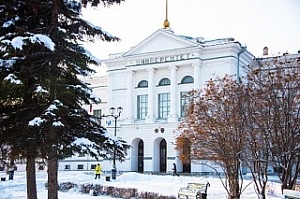The second part of the index “From the Imperial Tomsk to the National Research: 140 Years of Tomsk State University: A Bibliographic Index. Part 2: 1878 - 1917 (Literature in Foreign Languages)” was published at the TSU Publishing House. The index covers literature for the period from 1875 to 1917 in two dozen European languages.
The opening of the Imperial Tomsk University was a big event not only for Russia but it also caused a wide response from the world community. Newspapers and magazines in Europe, Asia, America, and Australia discussed the latest news and rumors about the construction of the university, faculty, and scientific discoveries of Tomsk scientists; travelers and researchers shared their impressions of university visits and joint expeditions. The compilers of the publication are Galina Polovtseva and Dmitry Nikitin, bibliographers of the Bibliographic Information Center of the TSU Research Library. They sought to present the geographical and linguistic diversity of publications dedicated to the first university beyond the Urals.
The news about the allocation of funds and the beginning of the construction of university buildings was perceived as a great achievement and caused great interest. The newspaper Voice of Mexico wrote that “Siberia is Moving towards Progress” (La Voz de México. 1875. 28 Oct. P. 2), and the observer of the Ljubljana Slovene noted not without sarcasm that Tomsk University is “new evidence of this what barbarians these Russians are: they open a higher school even in Siberia!”(Slovenec. Ljubljana, 1879. 29 julija. S. 4). News of the upcoming opening of the university reached even the distant Netherlands East Indies: the local “Java-bode” hurried to notify readers that the Siberian university would open in July 1886 (Java-bode: nieuws, handels-en advertentieblad voor Nederlandsch-Indie. 1886. 9 apr.).
The scientific community followed with interest the news about the appointment of professors to the university, about replenishment of the library with book collections, and new exhibits of the university museum. In 1886, “Nature” magazine noted that Tomsk University “already has a library of 50,000 volumes and a very valuable paleontological collection donated by Nicholas, Duke of Leuchtenberg” (Nature. 1886. Vol. 34, No. 868. P. 153–155).
An important role in alerting foreign colleagues was played by Russian newspapers published in German, Polish, and other languages. Thus, the St. Petersburg Medical Weekly (St. Petersburger medicinische Wochenschrift) regularly informed the public about university life news, and the Moscow newspaper Esperantists La Ondo de Esperanto reported on such an interesting aspect of Tomsk student life as the work of language circles (La Ondo de Esperanto. Moskvo, 1910. No. 11. P. 5-7).
In Moscow, reports were published on the scientific congresses held here, in which professors of Tomsk University also participated. In 1893, Professor N.F. Kashchenko made a report at the Anthropological Congress on the work of the Zoological Institute. The report was subsequently published in French (Kastschenko N. L`Institute zoologoque de l`Université Impériale de Tomsk // Congrès Internationaux d'Anthropologie et d'Archéologie préhistorique et de Zoologie à Moscou le 10/22 - 18/30 août: matéaux , réunis par le Comité d'organization des congrès concernant les expéditions scientifiques, les excursions et les rapports sur les questions touchant les congrès. Deuxième et derniere partie. Moscou, 1893. P. 34–44).
Many travelers who visited Tomsk left interesting notes and memories of the Siberian University.
Annette Meakin, the first foreign woman to travel on the Trans-Siberian Railway, talked about her meetings with V. Sapozhnikov, sharing with her the “secrets” of flower growing in Siberia, and a visit to the chemical laboratory of F. Kruger and the Zoological Museum, where she got acquainted with “a wonderful collection of local birds, interesting for both the naturalist and the hunter”. Describing her impressions of the university, Annette Meakin was surprised that “many students wear beards and completely refuse to use a razor” (Meakin A. M. B. A ribbon of iron / Annette M. B. Meakin. Westminster: A. Constable & Co., [1901]. 319 p.).
J. Legra, French professor, J. Wiggins, explorer of the Arctic seas, and H. K. Lee, American writer wrote about Tomsk University. Serbian teachers compared Tomsk University with Belgrade, and in Hungary, they watched with interest the scientific research of S.K. Kuznetsov, who studied the life of the Finno-Ugric peoples (Zichy Jenő Gróf harmadik Ázsiai utazása. Budapest; Leipzig, 1900).
With the beginning of the 20th century, the international press began to pay more and more attention to the revolutionary events in Russia. Student performances in university cities elicited a lively response in Belgium, France, the USA, Romania, and many other countries. Newspapers reprinted revolutionary appeals by students of Tomsk University, published reports on student strikes and meetings. Publications about this period in the history of Tomsk University comprise one of the largest sections of the index.
During this turbulent time, the scientific and social life of the university did not stop. The index contains information about publications that talk about the creation of B. Weinberg's aircraft, about the unique collections of the university library, about the medical research of Professor A. Kulyabko and many others.
The first Siberian University, its scientific and social activities were the subject of discussion in a vast space - from New Zealand to the Bermuda Islands. Foreign language publications sometimes show the life of Tomsk University from an unusual side for us, and therefore become even more interesting.
The bibliographic index “From the Imperial Tomsk to the National Research: 140 years of Tomsk State University. Part 2: 1878–1917 (Literature in Foreign Languages)” is available at the Electronic Library and Bibliographic Information Center of the TSU Research Library.

